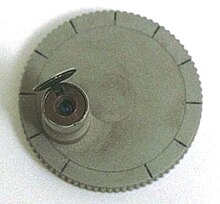Microdot
By Emanuel Goldberg invented microdots (Engl. Micro-dots ) are a means of technical steganography , which as a manifestation of a microfilm can be designated. These were mainly used in the Second World War by the National Socialists , who disguised letters or even site plans in them as i-dots or punctuation marks.
Manufacturing
The reduction process by means of photographic imaging takes place in two stages: In the first step, the source (typically a typewriter page ) is mapped onto a negative (?) The size of a postage stamp using a precision camera . In the second step, the developed negative is imaged through the optics of a microscope onto a photo plate made of thin glass, which is in the position of the slide .
At approx. 1 mm 2, the reduced image is roughly the size of a point typed with a typewriter. After development, the glass plate is coated with a layer of collodion , whereupon the point is poked out with an injection needle and treated with iodine in order to also darken the transparent areas.
A common way to get the information across to the recipient is to split the corner of a postcard with a razor blade, slide the point in, and glue it back on.
The receiver sets the point in a chemical bath (for example, the developer solution Rodinal ) to the black-violet to colorless iodine iodide to reduce , and can then look at the information under a microscope.
The Stasi developed special microdot cameras that produced a 1.4 × 2 mm negative.
Modern use
Microdots can be used to discreetly mark individual objects. The focus is on the identification of stolen goods. The micropoint contains a unique identification number as well as the web address for access to the database to identify the registered owner. At the beginning of 2017, however, the police in Germany were not yet in a position to use this technology in terms of personnel and logistics. She therefore advised against their use, as microdots also do not have a deterrent effect on theft.
literature
- Klaus Schmeh : Hidden Messages; The fascinating story of steganography . Heise, Hannover 2009, ISBN 978-3-936931-54-9 .
- Janusz Piekalkiewicz: World history of espionage. Augsburg 1993, ISBN 3-89350-568-7 , p. 518.
Individual evidence
- ^ "One of the most famous of the technical stenographic methods, employed by the Germans during World War II, was the use of the microdot (invented by Emanuel Goldberg in the 1920s) as a period in typewritten documents." In: Richard A. Mollin: RSA and Public-key Cryptography . Chapman & Hall / CRC, 2002, ISBN 1-58488-338-3 , p. 2.
- ↑ Mikratkamera Uranus M. In: German Spy Museum. Retrieved February 3, 2020 (German).
- ↑ Product Security: valuables secure the network home safe , accessed on 02.12.17
